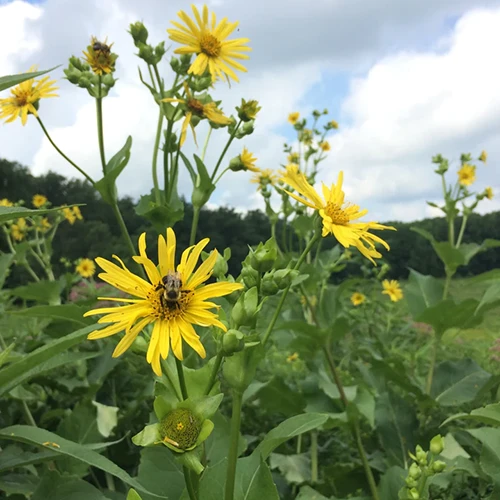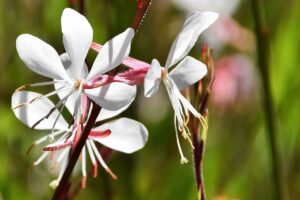Silphium spp.
Tall and leggy members of the sunflower family (Asteraceae), the rosinweeds are excellent perennial naturalizers, capable of colonizing a multitude of garden conditions.
Also known as cup plant, compass plant, and prairie dock, depending on the species, the many names of the members of the Silphium genus are a nod to the plants’ large leaves and sticky exudate, rosin, or sap.

We link to vendors to help you find relevant products. If you buy from one of our links, we may earn a commission.
Native to North America, they can be found growing up to six feet tall in dry meadows, moist ditches, and woodland edges from Louisiana and Indiana east to Pennsylvania and Georgia.
As tough as the land they hail from, these prairie natives are deep-rooted and long-lived – two attributes that make them a cinch to grow in the garden.
The tall clusters of summer-blooming, yellow flowers are beloved by pollinators and the fall-ripening seed heads attract flurries of birds.
Read on to learn how to grow these giant beauties at home in your own slice of prairie.
What You’ll Learn
Cultivation and History
Before you jump on Google and start reading about silphium’s storied past in ancient Greece, let’s be clear that that silphium is different from this one.
The word “silphium” is derived from an old Greek word for an extinct resin-bearing plant native to the Mediterranean, but this species was completely different from members of the Silphium genus.

Rosinweed is a North American native. In its natural habitat, given the right conditions, it can create large stands of sunny yellow flowers.
Tribes native to areas within the plants’ range used the sticky resin as a mouth cleanser, just as we might a stick of Wrigley’s.
Rumor has it the plants are useful to treat a variety of medical ailments from kidney and liver disease to premature birth. But don’t go making a cup of cup plant tea just yet! Never use plants to treat any illness without the guidance of an expert.
Adapted to the vagaries of life on the plains, rosinweed can withstand extreme temperature swings and rapid changes in weather.

Although species in this genus have been used in horticulture for more than two hundred years, they have become more common in nurseries only recently, and you will probably have to go to a garden center specializing in natives to find compass plant and other species.
These days, there is interest in using several members of the genus as an oilseed crop and for biofuel, potentially replacing sunflower, soy, canola, or corn as a tougher, easier to grow alternative.
While the seeds are not substantial enough for you to snack on, in some parts of the US, rosinweed’s young spring leaves are a popular, wild alternative to other tender greens.
Word to the wise, like its cousin the dandelion, Silphium leaves are fiercely bitter if they’re not blanched first.
Rosinweed Propagation
Most home gardeners grow rosinweed from plants purchased in a nursery.
But under the right conditions, they can be grown from seed collected from wild populations, a stand of garden-grown plants, or seed purchased online.
From Seed
Although rosinweed readily reseeds in its natural habitat, it has a relatively low germination rate and can be hard to establish in the garden this way.
If you’re looking for a surefire way to get rosinweed growing in the garden, head to a nursery to purchase a mature specimen instead.
Seeds need at least 60 days of cold stratification, so ideally, start them directly in the garden in the fall. To do it right, lightly press seeds into the soil, and let them be for the winter. They will germinate in the spring.
Seeds can also be artificially cold stratified and started indoors. Place the seed in a handful of moist but not soaking vermiculite in a sealed zip-top bag and put it in the refrigerator for 60 days.
Next, before sowing in two-inch pots, nick the seeds to allow moisture to penetrate the hard seed coat. This can be done with a nail file.
Fill the pots with moist potting soil and keep in a sunny location until the last frost has passed, then move outdoors.
If direct sowing outside, the thawing and freezing cycles of winter will break the seed coat enough to allow germination to commence, so there’s no need to nick the seeds in that case.
See our guide to winter-sowing flower seeds for more information.
When seedlings emerge, tend them carefully, watering in dry spells and ensuring they receive adequate sunlight.
It takes two to three years for rosinweed to grow large enough to fend for itself and reach flower-producing maturity.
Transplants
Depending on where you live, it may be tough to find rosinweed for sale.
Several states have made it illegal to sell the species commonly called cup plant (S. perfoliatum) due to its rapid growth.
Conversely, the species S. laciniatum is threatened or endangered in certain areas of its native range, which may keep it out of nursery yards, too.
Your only choice for potted starts may be a local garden club exchange, or the kindness of a fellow prairie-loving neighbor. Native-focused companies with online shops may offer small plants for sale, too.
If you’ve managed to start your own plants from seed, harden them off gradually by exposing them to outdoor conditions a little at a time. Transplant in a sunny location as soon as the threat of frost has passed.
Remember to site this quick grower somewhere with lots of elbow room for its long and leggy limbs. Plant transplants so the new, green growth is level with the soil, then water well.
How to Grow Rosinweed Plants
Ultimately, growing rosinweed doesn’t take much more than a willingness to dig a hole.
This genus of plants is tenacious, and adapted to a wide variety of conditions.
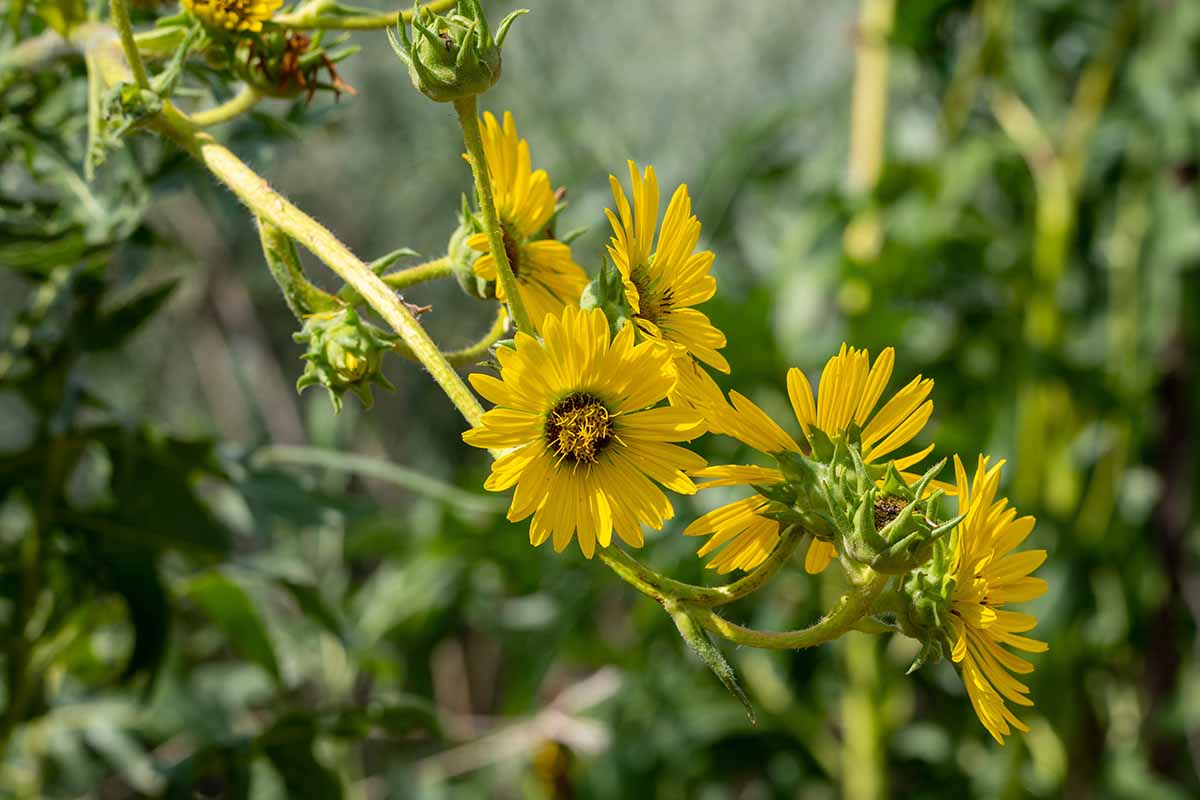
It’s precisely this adaptability that has led some regions outside their native range to label the species known as cup plant as invasive.
The creeping, rhizomatous roots of this member of the genus can spread rapidly, creating dense stands of clones and outcompeting other plants.
Tolerant of the dry soils common to the American prairie, rosinweed is a good choice for neglected sites that are too dry or nutrient poor for other garden perennials.
Although consistently wet soils aren’t ideal, these plants do grow well in moist, rich conditions, especially given good air circulation and ample sunlight.
Bottom line? Throw this plant almost anywhere in the garden and it will grow like a weed.
With your pot of Silphium in hand, select a site with good sun exposure and enough space to accommodate this perennial’s tendency to spread – at least two to three feet of space on either side.
Think about rosinweed’s companions when you get to site selection, too.
This plant can be a bit of a bully and it’s up to you to protect your garden’s shrinking violets. The back of a large border might work, or a wilder area of the garden you’ve been wanting to naturalize.
Compass plant’s sprawling, lateral roots work to slow soil erosion on slopes that may be tricky to plant on, too.
Growing Tips
- Direct sow seed in fall.
- If starting in pots, nick seed coat with a nail file prior to sowing.
- Site plants in an area with plenty of space and sunlight.
Maintenance
No real maintenance is required for these plants to flourish. Every three to four years, divide the clump and disperse the divisions to keep new growth vigorous, transplanting as described above.

In high winds, tall plants may need staking. Leave dead flower stalks up over the winter to provide habitat for nesting bees and other pollinators.
Rosinweed Species to Select
With at least 17 species belonging to the Silphium genus, gardeners have a lot to choose from when it comes to selecting the kind of rosinweed that’s right for you.
Perfoliatum
The most common, showiest, and most popular species is S. perfoliatum.
Often called cup plant for its leaves, which pool and gather water, this species is wildlife friendly and laden with flowers come midsummer.
Hardy in all but the coldest of conditions, S. perfoliatum thrives in USDA Hardiness Zones 3 to 9.
Despite its popularity in gardens around the globe, this species has not been tinkered with by plant breeders much.
You may come across certain cultivars, such as ‘Maya,’ but the straight species is what’s most commonly available for growing.
Seed is available at Earthbeat Seeds and packs of live plants may be purchased from Nature Hills Nursery.
Terebinthinaceum
Prairie dock (S. terebinthinaceum) is another attractive species available at native plant nurseries in the know.
This large-leafed perennial grows to heights of up to eight feet and can live for decades.
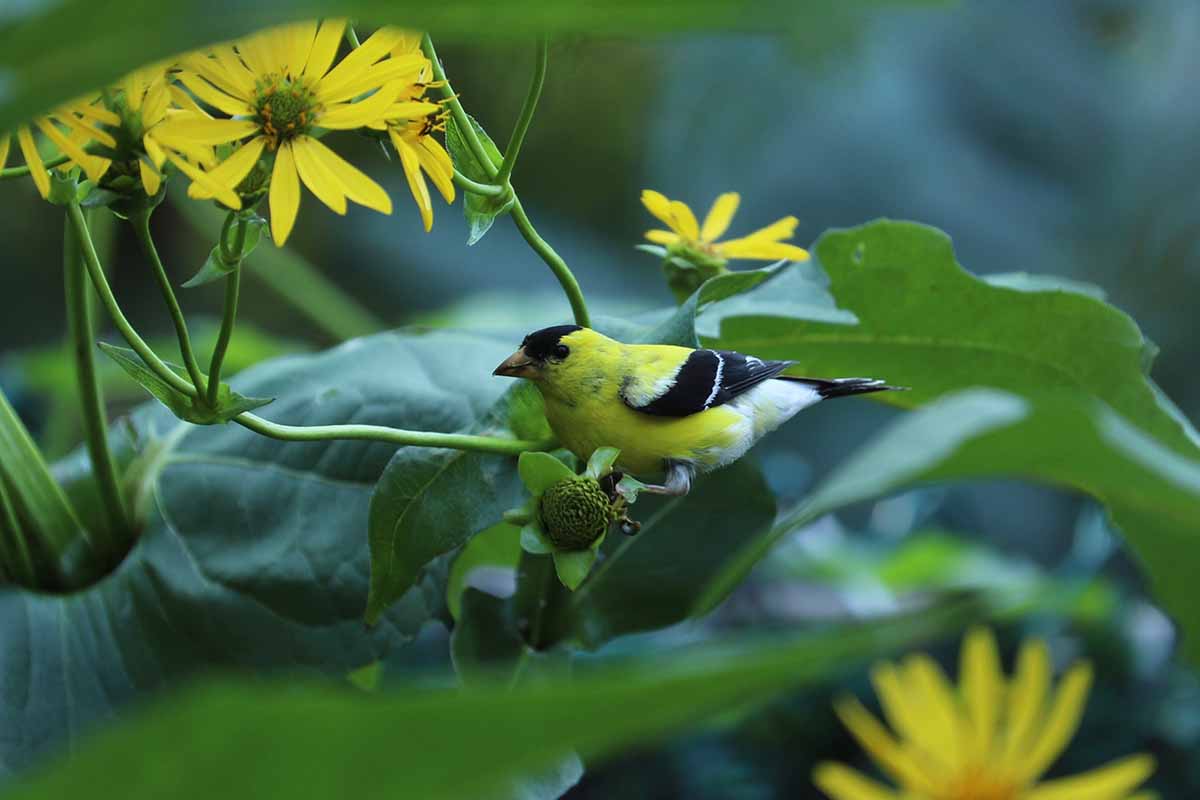
Prairie dock is less rhizomatous than other species, but given the right conditions, will form offshoots which can be divided and dispersed throughout the garden.
For really dry sites, this is the species to spring for. As with all members of this genus, its seeds are beloved by granivorous birds, like goldfinches.
Grow this species in USDA Hardiness Zones 4 to 9.
Laciniatum
The common name for S. laciniatum, compass plant, comes from a tendency to orient its leaves in a north-south direction, to maximize sun exposure. This species can also be found for sale occasionally.

It sports the same bright clusters of yellow flowers as its cousins, but also grows attractive, toothed leaves, as its botanical name suggests.
For clay-rich, moist soils, this species is the one to choose. Plant it in USDA Hardiness Zones 3 to 8.
Managing Pests and Disease
Adapted over the course of many millennia to the conditions of the American plains, rosinweed is as tough as they come.
Pest problems and disease are rare, and most herbivores will eschew plants from this genus unless there’s absolutely nothing else to eat.
Numerous butterflies use this group of plants as larval hosts, meaning you may find a very hungry caterpillar or two chomping on its leaves.
These kinds of herbivores won’t hurt your plants and should be left to metamorphose into butterflies.
Diseases common to all garden perennials, such as downy mildew and leaf spot, can sometimes plague Silphium in particularly dry or very wet years. But ultimately, these problems won’t hold it back.
Best Uses for Rosinweed Flowers
These reliable perennials are best used in wild gardens and naturalized areas where roots can run rogue and tall stems don’t need taming.
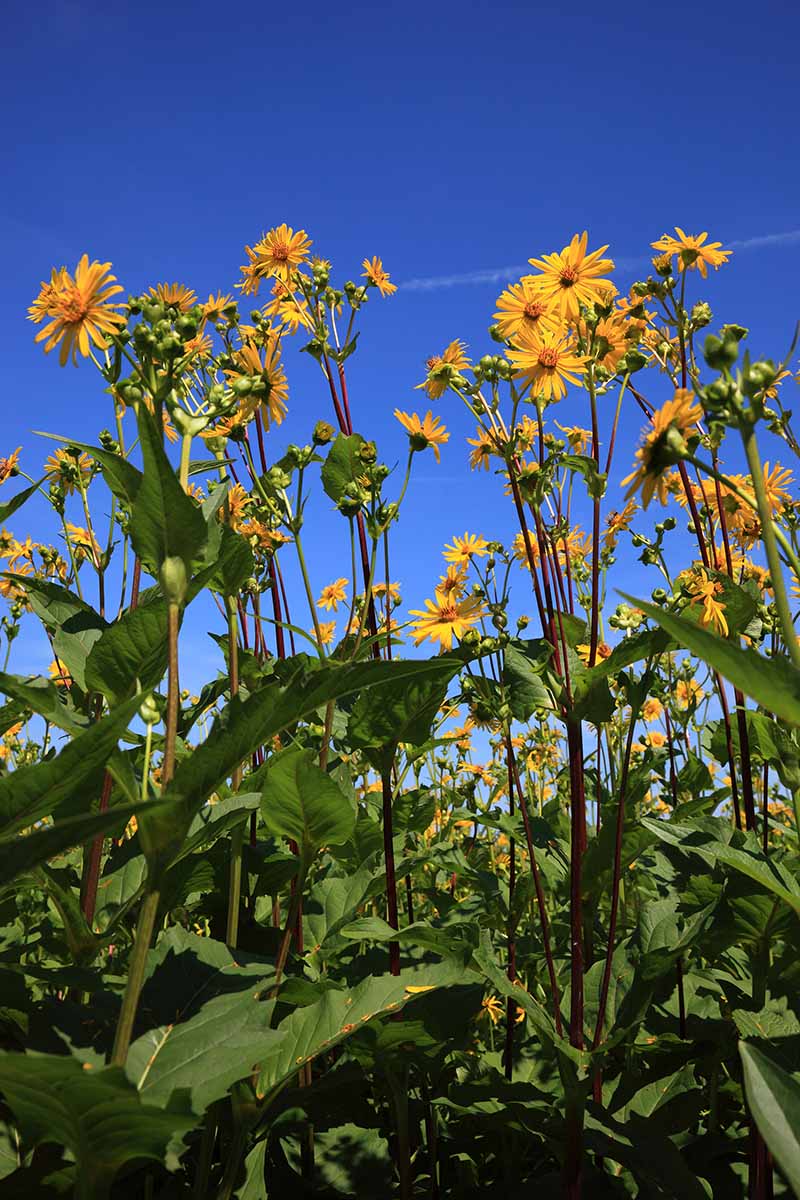
Use rosinweed to turn rugged bare spots on the landscape into colorful wildlife havens or add a splash of sunny yellow to the back of the border.
The cut flowers hold up reasonably well in a vase and look beautiful as part of a late summer wildflower bouquet.
Quick Reference Growing Guide
| Plant Type: | Herbaceous perennial | Flower / Foliage Color: | Yellow/green |
| Native to: | Midwestern and southeastern US | Water Needs: | Low |
| Hardiness (USDA Zone): | 4-9 | Tolerance: | Drought, herbivory, extreme heat, extreme cold |
| Bloom Time/Season: | Summer-early fall | Maintenance: | Low |
| Exposure: | Full sun to part shade | Soil Type: | Average |
| Time to Maturity: | 2 years | Soil pH: | 6.0-8.0 |
| Spacing: | 2-3 feet | Soil Drainage: | Well-draining |
| Planting Depth: | 1/4 inch (seed), 2-4 inches (seedlings), 6-8 inches (mature transplants) | Attracts: | Birds, butterflies, flies, honey bees, native bees, wasps |
| Height: | 3-8 feet | Uses: | Erosion control, habitat, wildlife plant |
| Spread: | 3-4 feet | Family: | Asteraceae |
| Growth Rate: | Fast | Genus: | Silphium |
| Common Pests and Diseases: | Red aphids; downy mildew, leaf spot, rust | Species: | Asteriscus, integrifolium, laciniatum, perfoliatum, terebinthinaceum |
Bring the Prairie Home
If you’re looking for a permanent summertime performer for a tricky spot in the garden, rosinweed may be right for you.
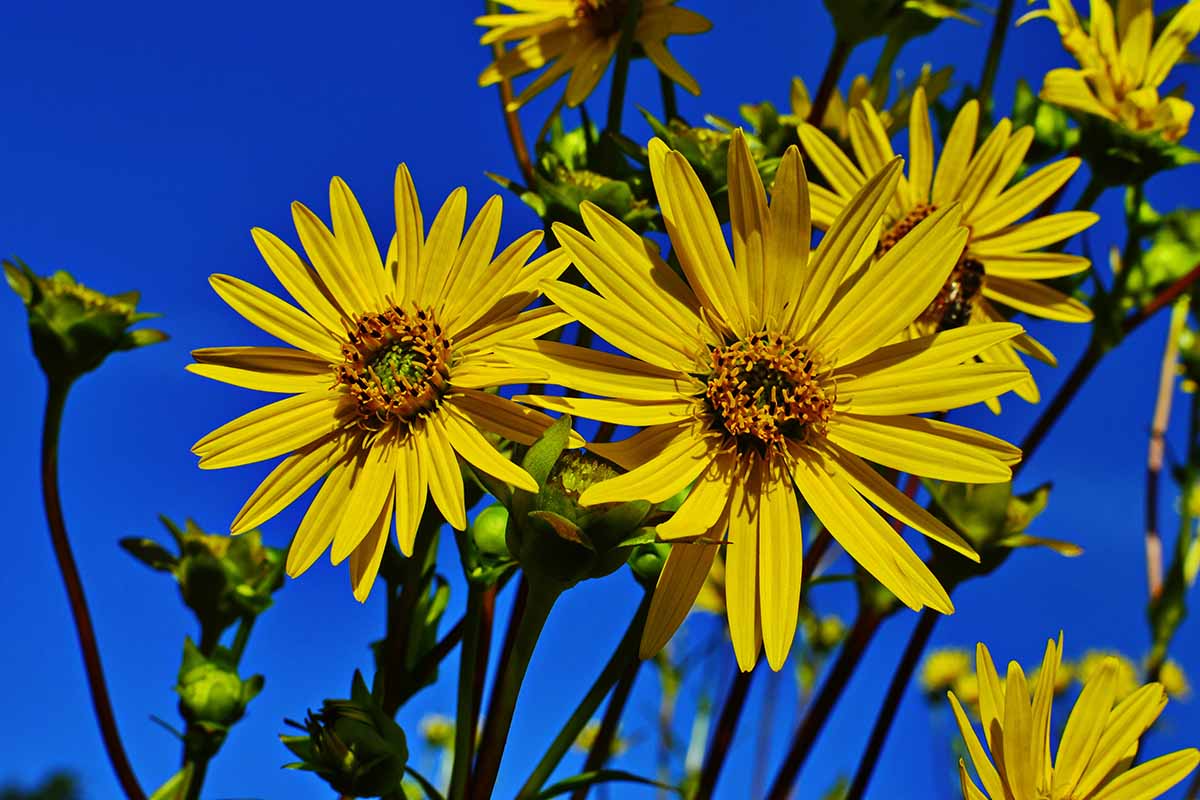
Pollinators of all stripes will go wild for it, and its bright and cheery flowers will bloom with virtually no help from you, year after year.
As always, feel free to post your rosinweed triumphs, challenges, and questions in the comments.
And if you’d like to expand your native flower garden, check out the following articles for more info:
